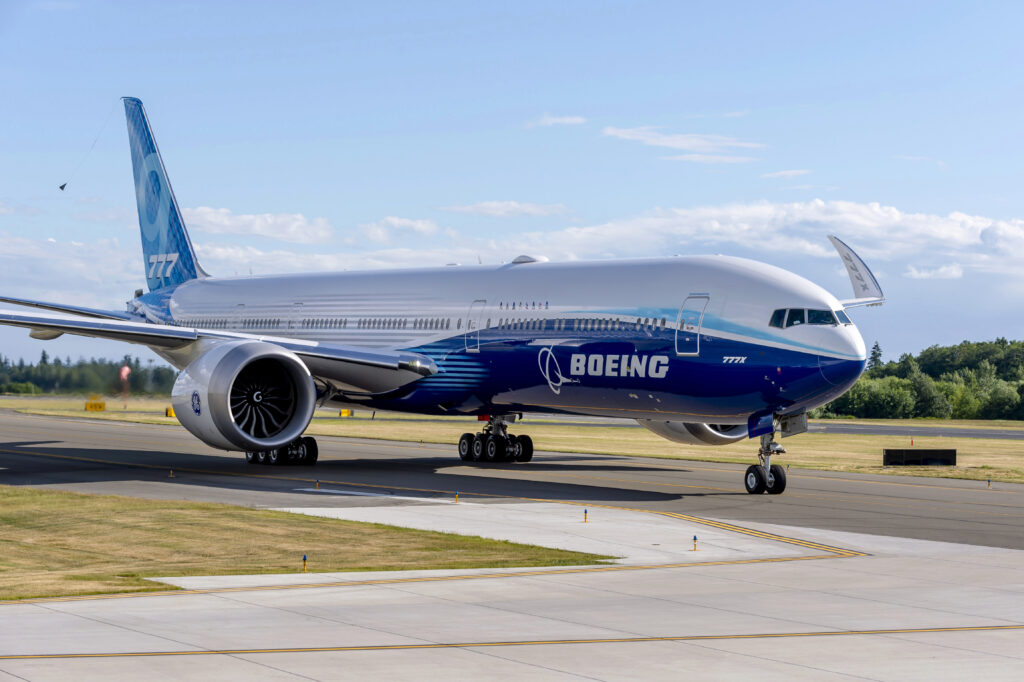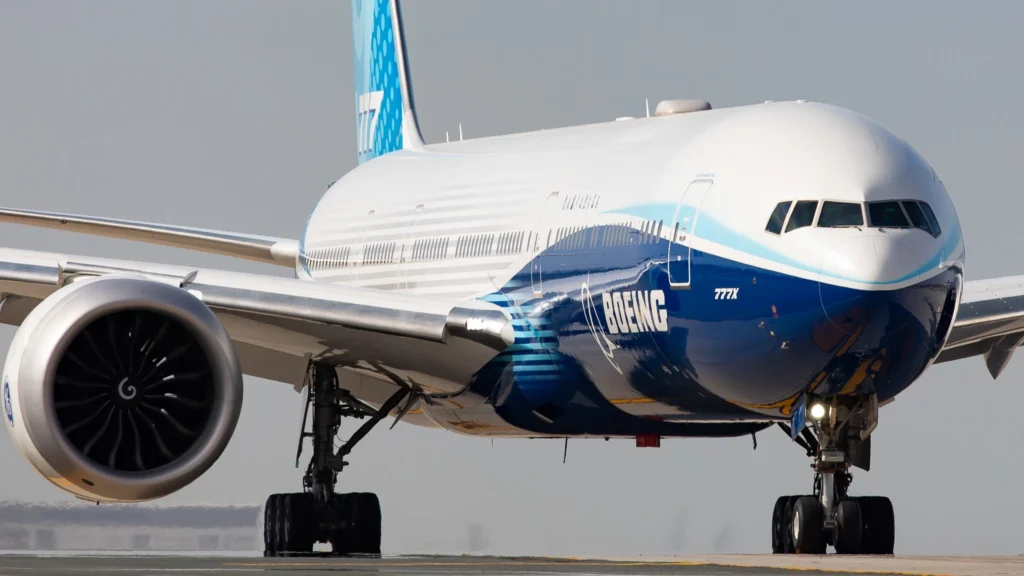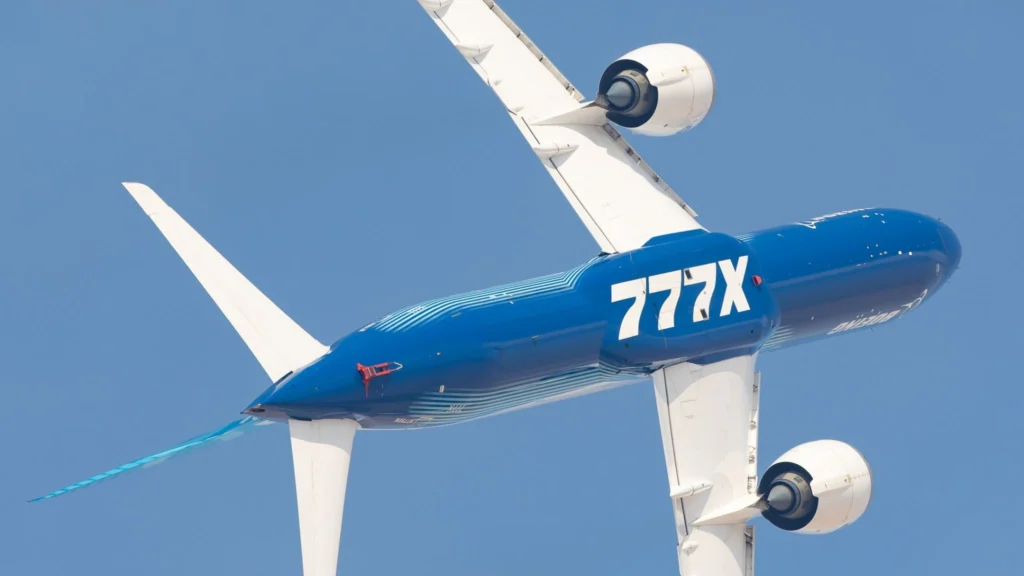
LONDON- Boeing designed the 777X as a revolutionary widebody aircraft that builds on the success of the 777 while introducing larger windows and advanced passenger comfort features.
The 777X combines cabin innovations from the 787 Dreamliner with new technologies, offering airlines flexibility in layouts and improved efficiency.
Airports such as Dubai International (DXB) and Frankfurt (FRA) are expected to be among the first major hubs to welcome this new generation twinjet.
 Photo: Boeing
Photo: BoeingDesigning A New Cabin Standard
The Boeing 777X marks a turning point in passenger-focused aircraft design, with its wider fuselage, modular cabin architecture, and the industry’s largest windows on a twinjet.
These windows are 29% larger than those on the Airbus A350-1000 and 16% larger than the earlier 777.
Positioned higher on the fuselage, they provide natural light and improved views for more passengers, including those seated in the middle.
To achieve this, Boeing engineered thinner sidewalls, redesigned ceiling arcs, and concave overhead bins that increase spaciousness while reducing the enclosed “tube-like” feel common in earlier cabins.
A full-scale 40-foot cabin mock-up was tested before the official launch in 2013, ensuring airline feedback directly shaped the design.
According to Simple Flying, this collaborative process gave Boeing critical insights into passenger preferences.
At the 2015 Farnborough Airshow, Bob Feldmann, 777X program vice president, emphasized:
Boeing has always been committed to research that leads to the right innovations needed to deliver a superior passenger experience.
Bob Feldmann, 777X Program VP
 Photo: Qatar Airways
Photo: Qatar AirwaysPassenger Experience Enhancements
The 777X inherits the Dreamliner’s cabin altitude of 6,000 feet and higher humidity, reducing fatigue and improving hydration. Advanced filtration systems provide cleaner cabin air.
Combined with “smooth ride technology” that minimizes turbulence, these features create a healthier, calmer environment.
Noise reduction was a major engineering focus. The GE9X engines use a high bypass ratio with redesigned nacelles for quieter thrust.
Added insulation, along with double the number of air nozzles operating at lower velocity, further reduces cabin noise.
Next-generation LED and layered lighting systems allow airlines to create different ambiance throughout the flight. From boarding to dining to rest periods, crews can program distinct moods, enhancing comfort while offering branding flexibility.
 Photo: Boeing
Photo: BoeingAdvanced Window Technology
A highlight of the 777X is its use of Gentex Corporation’s latest electronically dimmable windows (EDWs).
These windows dim twice as fast as earlier versions and block 99.999% of visible light. They eliminate the need for physical shades while still letting passengers enjoy outside views.
The EDW system features ultra black low end transmission, thin-film coatings to block harmful infrared and ultraviolet rays, and electrochromic gel that responds quickly to electricity.
This makes the system not only more reliable but also less costly to operate and maintain compared to traditional blinds.
Steve Downing, Gentex CEO, noted in 2019:
With careful design and collaboration with Boeing, our teams developed a robust EDW system that integrates seamlessly for optimal aesthetics, performance, and reliability.
Steve Downing, Gentex CEO
 Photo: Boeing
Photo: Boeing777X Performance And Specifications
The 777X comes in two main variants:
- 777-8: 395 seats, 8,745 nautical miles range.
- 777-9: 426 seats, 7,285 nautical miles range.
Both feature folding wingtips that extend wingspan in flight to 235 feet, powered by GE9X engines, the largest and most efficient commercial turbofans ever built.
Boeing CEO Kelly Ortberg reaffirmed at a 2025 investor event that certification is progressing, with deliveries expected to begin shortly after regulatory approval.
 Photo: Clément Alloing
Photo: Clément AlloingComparison With Other Aircraft
| Typical Seating (2-class) | 426 | 395 | 369 | 365 |
| Range | 7,285 NM (13,500 km) | 8,745 NM (16,190 km) | 8,700 NM (16,100 km) | 7,370 NM (13,650 km) |
| Windows | 162 sq in, 29% larger than A350 | Same as 777-9 | Standard A350 windows | Smaller legacy 777 windows |
| Cabin Altitude | 6,000 ft | 6,000 ft | 6,000 ft | 8,000 ft |
| Cabin Width | 16 in wider than A350 | Same as 777-9 | Narrower by comparison | Narrower older design |
| Humidity & Filtration | Advanced system | Same as 777-9 | Advanced system | Basic system |
| Engines | GE9X high-bypass, fuel-efficient | Same as 777-9 | Rolls-Royce Trent XWB-97 | GE90-115B |
| Noise Reduction | Nacelle redesign, insulation, dual nozzles | Same as 777-9 | Quieter than legacy jets | Higher cabin noise |
| Entry Into Service (planned) | Mid-2020s (after certification) | Mid-2020s | 2018 | 1998 |
 Photo: Clément Alloing
Photo: Clément AlloingFuture Outlook
The redesign of windows and lighting stemmed from research showing travelers strongly prefer seeing the horizon and enjoying natural light.
Boeing responded with higher, wider windows, layered lighting, and flexible cabin layouts that improve well-being.
Dennis Eng, Boeing’s director of 777X Interiors, summarized: “The 777X will redefine the total passenger experience. All of the features we are designing are working together as a package to create a new standard in long-haul travel.”
Stay tuned with us. Further, follow us on social media for the latest updates.
Join us on Telegram Group for the Latest Aviation Updates. Subsequently, follow us on Google News
Boeing 777X Uses the Largest Jet Engines in the World, Why?
The post Boeing 777X Has 29% Larger Windows than This Aircraft, Here’s Why appeared first on Aviation A2Z.











